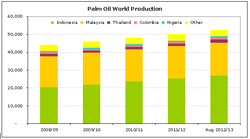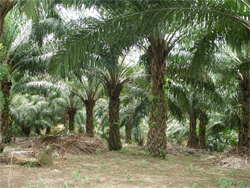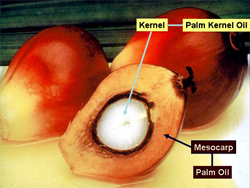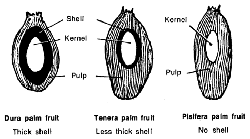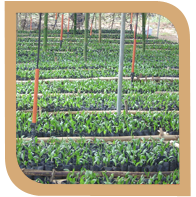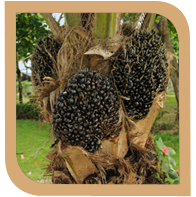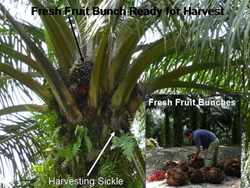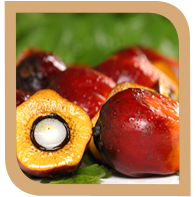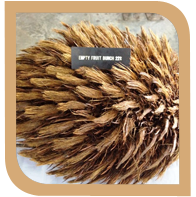
|
||||||||||||||||||||||||||||||||||||
Horticulture :: Plantation Crops :: Oilpalm |
||||||||||||||||||||||||||||||||||||
Varieties – Dura, Tenera, Pisifora
Climate: Temperature is 210 C to 320C, annual rainfall - 200 cm and relative humidity - 75 – 100 %. Altitude – 450 -900 m above MSL. Soil: Moist deep, loamy soils, rich in humus with good water permeability are suitable. Soil pH - 4 - 6 Nursery techniques: Fruits are separated from the bunch. Remove the exocarp and mesocarp with knife. Dry the seeds on concrete or wooden floors under shade for 2 days and stored for 3-9 months. Seeds are soaked in water for 5 days (changing the water daily) and spread out to dry for 24 hours. Dried seeds are put in 250 gauge and 23 X 13 cm size polythene bags filled with top soil, sand and well decomposed cattle manure in equal proportions and placed for germination. Germination (90-95 %) starts 10-12 days. Apply fertilizer mixture containing 15:15:6 of NPK @ 8 g in 5 litres of water for 100 seedlings
Planting: Pit size 60 cm3. Planting can be done in triangular system with spacing of 9 m x 9 m x 9 m, accommodating 140 palms/ha, May-June is the suitable season for planting. Mulching: Empty bunches, male flowers, coconut husk, sugarcane trash can be used as mulch. Irrigation : Yielding palm of 3 years age and above – minimum of 150 litres/day. Drip irrigation: 5 hrs of irrigation per day using 4 drippers per palm @ 8 litres of water /hr/dripper. Ablation: Removal of all inflorescences during the initial three years to gain adequate stem girth, vigour and root system. Ablation is done at monthly intervals by pulling out the young inflorescence. Manuring: For five year old palm, apply 50 kg compost of FYM or grenn leaves may be applied. Fertilizer schedule: N: P: K : Mg So4 (g/palm/year)
Nutrients - functions and deficiency symptoms b) Phosphorus: In oil palm seedlings, P deficiency causes the older leaves to become dull and assume a pale olive green colour while in adult palms high incidence of premature desiccation of older leaves occurs. Phosphorus application increases the bunch production rate, bunch weight, number of female inflorescences and thereby the sex ratio. However, lack of response to P due to P fixation in soils is very common in the tropics. Eventhough the main effect of phosphorus on the productivity of the palm has not been significant in most studies, it gives a positive interaction with nitrogen and potassium. c) Potassium: When potassium is deficient, growth as well as yield is retarded and it is translocated from mature leaves to growing points. Under severe deficiency, the mature leaves become chlorotic and necrotic. Confluent orange spotting is the main K deficiency condition in oil palm in which chlorotic spots, changing from pale green through yellow to orange, develop and enlarge both between and across the leaflet, veins and fuse to form compound lesions of a bright orange colour. Necrosis within spots is common, but irregular. Mid crown yellowing is another prominent K deficiency condition of the palm in which leaves around the 10th position on the phyllotaxy become pale in colour followed by terminal and marginal necrosis. A narrow band along the midrib usually remains green. There is a tendency for later formed leaves to become short and the palm has an unthrifty appearance with much premature withering. d) Magnesium: In adult oil palm and in seedlings in the field, severe Mg deficiency symptoms are most striking and have been named as ‘orange frond’. While the lower most leaves are dead, those above them show a gradation of colouring from bright orange on the lower leaves to faint yellow on leaves of young and intermediate age. The youngest leaves do not show any discolouration. The most typical Mg-deficiency symptom is the shading effect in which the shaded portion of the leaflet will be dark green while the exposed portion of the same leaflet is chlorotic. Heavy rates of K applications induce Mg-deficiency, particularly on poor acid soils. e) Micronutrients: Micronutrient elements, iron, manganese, copper and zinc are not generally found limiting in the nutrition of oil palm on acid soil conditions. Boron deficiency is occasionally found on young palms in the field showing a reduction of leaf area in certain leaves producing incipient ‘little leaf’, advanced ‘little leaf’ with extreme reduction of leaf area and bunching and reduction in the number of leaflets and ‘fish-bone’ leaf. The ‘fish-bone’ leaves are abnormally stiff with leaflets reduced to projections. Leaf malformations including ‘hook leaf’ and corrugated leaflets are some other associated symptoms. Soil application of 50 - 200 g borax decahydrate, per palm, depending on age, and severity of symptoms is practiced for correcting the malady. Maintenance of paths Ablation Cover cropping: Pueraria phaeseoloides, Calopogonium mueconoides, Centrosema prutascens, Mimosa invisa, Mucana sp. Insect pollination in oil palm Plant Protection Pests: Red palm weevil: Removal of damaged and rotten bunches and apply tar to the wounds and cuts on the stem portion to avoid egg laying. Trap the adult beetles using pheromone baits. Diseases: Bud rot disease: The affected crown should be removed and drenched with Carbendazim or Thiram @ 0.1 %. Basal stem rot: Removal and destruction of diseased palms. Apply 5 kg of Neem cake per year per tree.Root feeding with Calixin 10 ml or 10 g Aureofungin sol in 100 ml of water per tree per year. Harvesting: First harvest can be done 3.5 to 4 years after planting. Few ripe fruits are loose/fall off indicates the bunch is ready for harvest. In Young palms, Chisel harvesting is followed. If palms become taller (from 10th year onwards), then harvesting is done by hook. Harvesting rounds should be made as frequent as possible to avoid over ripening of bunches. Harvesting rounds of 10-12 days are generally practiced. During rainy season harvesting rounds of 6-7 days are followed.
Yield: 25 – 30 tonnes of fresh fruit bunches/ hectare.
|
||||||||||||||||||||||||||||||||||||
© All Rights Reserved. TNAU 2008 - 2024. |
||||||||||||||||||||||||||||||||||||
